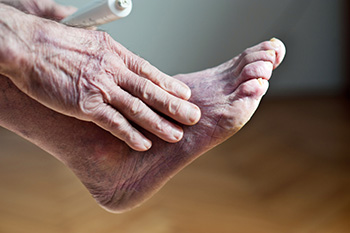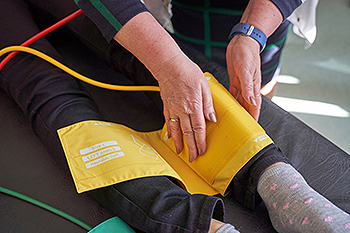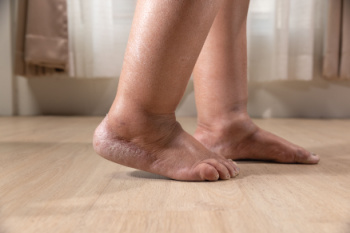Items filtered by date: September 2025
Healthy Toenails and Common Problems That Affect Them

Toenails can change for many reasons, and those changes are often more than cosmetic. Thickened or discolored nails may point to fungal infections, while trauma or tight shoes can alter their shape. Ingrown toenails are another common issue, where the edge of the nail presses into the surrounding skin, leading to pain and sometimes infection. Circulation concerns, diabetes, or conditions such as psoriasis can also influence nail health. Treatments depend on the underlying cause. Fungal infections may require antifungal therapy, while ingrown nails might benefit from careful trimming, wearing proper footwear, or professional podiatric care. Additionally, pressure related damage can often be managed with adjustments to shoes and routine nail maintenance. Practicing good hygiene and keeping nails cut straight across helps prevent many problems. If you are experiencing nail changes or painful ingrown nails, it is suggested that you see a podiatrist for appropriate treatment solutions.
Toe pain can disrupt your daily activities. If you have any concerns, contact one of our podiatrists of Florida. Our doctors can provide the care you need to keep you pain-free and on your feet.
What Causes Toe Pain?
Most severe toe pain is caused due to a sports injury, trauma from dropping something heavy on the toe, or bumping into something rigid. Other problems can develop over time for various reasons.
Toe pain can be caused by one or more ailments. The most common include:
- Trauma
- Sports injury
- Wearing shoes that are too tight
- Arthritis
- Gout
- Corns and calluses
- Hammertoe
- Bunions
- Blisters
- Ingrown toenails
- Sprains
- Fractures (broken bones)
- Dislocations
When to See a Podiatrist
- Severe pain
- Persistent pain that lasts more than a week
- Signs of infection
- Continued swelling
- Pain that prevents walking
Diagnosis
In many cases the cause of toe pain is obvious, but in others, a podiatrist may want to use more advanced methods to determine the problem. These can range from simple visual inspections and sensation tests to X-rays and MRI scans. Prior medical history, family medical history, and any recent physical traumatic events will all be taken into consideration for a proper diagnosis.
Treatment
Treatments for toe pain and injuries vary and may include shoe inserts, padding, taping, medicines, injections, and in some cases, surgery. If you believe that you have broken a toe, please see a podiatrist as soon as possible.
If you have any questions please contact our offices located in North Miami, and Pembroke Pines, FL . We offer the newest diagnostic and treatment technologies for all your foot and ankle needs.
Systemic Sclerosis and Its Impact on Feet

Color changes in the feet, such as redness, blue tones, or pale patches, can be an early indicator of autonomic involvement in systemic sclerosis, a rare autoimmune disorder. Systemic sclerosis affects blood flow by tightening blood vessels and altering circulation, which can cause noticeable color shifts in response to temperature or stress. Feet may appear blue due to reduced oxygen, red with increased blood flow, or pale when circulation is restricted. These color changes may also come with symptoms like numbness, tingling, or sensitivity to cold, signaling an underlying problem with the autonomic nervous system, which regulates involuntary functions, including blood vessel dilation. If you have this condition and it affects your feet, it is strongly suggested that you visit a podiatrist to manage symptoms and prevent complications. These foot specialists can assess circulation, suggest protective strategies for temperature changes, and work with other specialists to ensure proper blood flow and nerve function, ultimately helping to maintain foot health.
Some foot conditions may require additional professional care. If you have any concerns, contact one of our podiatrists of Florida. Our doctors can provide the care you need to keep you pain-free and on your feet.
Rare Foot Conditions
The majority of foot conditions are common and can be treated by a podiatrist. Standard diagnostic procedures are generally used to identify specific conditions and treatment can be rendered. A podiatrist also treats rare foot conditions which can be difficult to diagnose and may need extra attention and care.
There are many rare foot conditions that can affect children. Some of these can include:
- Freiberg’s disease
- Kohler’s disease
- Maffucci syndrome
Freiberg’s disease - This can be seen as a deterioration and flattening of a metatarsal bone that exists in the ball of the foot. It typically affects pre-teen and teenage girls, but can affect anyone at any age. Symptoms that can accompany this can be swelling, stiffness, and the patient may limp.
Kohler’s disease - This often targets the bone in the arch of the foot and affects younger boys. It can lead to an interruption of the blood supply which ultimately can lead to bone deterioration. The patient may limp or experience tenderness, swelling, and redness.
Maffucci syndrome - This affects the long bones in a child’s foot leading to the development of abnormal bone lesions. They are benign growths and typically develop in early childhood and the bones may be susceptible to breaking.
A podiatrist can properly diagnose and treat all types of rare foot conditions. If your child is affected by any of these symptoms or conditions, please don’t hesitate to call our office so the correct treatment method can begin.
If you have any questions, please feel free to contact our offices located in North Miami, and Pembroke Pines, FL . We offer the newest diagnostic and treatment technologies for all your foot care needs.
Peripheral Artery Disease and the Feet

Peripheral artery disease, or PAD, affects the blood vessels that deliver oxygen-rich blood to the legs and feet. The narrowing of these arteries can cause serious complications in the lower limbs. When blood flow to the feet is restricted, symptoms such as pain while walking, coldness, tingling, or numbness may develop. Cuts or sores on the feet and ankles may take longer to heal, raising the risk of infection and tissue damage. People with diabetes are at an even higher risk of peripheral artery disease, as high blood sugar can further damage blood vessels and reduce circulation. In advanced cases, untreated PAD can contribute to ulcer formation and limb loss. A podiatrist can evaluate circulation in the feet, identify early warning signs, and recommend effective treatment to restore blood flow and protect against further damage. If you have symptoms of peripheral artery disease that are affecting your feet, it is suggested that you schedule an appointment with a podiatrist for an evaluation and appropriate treatment options.
Peripheral artery disease can pose a serious risk to your health. It can increase the risk of stroke and heart attack. If you have symptoms of peripheral artery disease, consult with one of our podiatrists from Florida. Our doctors will assess your condition and provide you with quality foot and ankle treatment.
Peripheral artery disease (PAD) is when arteries are constricted due to plaque (fatty deposits) build-up. This results in less blood flow to the legs and other extremities. The main cause of PAD is atherosclerosis, in which plaque builds up in the arteries.
Symptoms
Symptoms of PAD include:
- Claudication (leg pain from walking)
- Numbness in legs
- Decrease in growth of leg hair and toenails
- Paleness of the skin
- Erectile dysfunction
- Sores and wounds on legs and feet that won’t heal
- Coldness in one leg
It is important to note that a majority of individuals never show any symptoms of PAD.
Diagnosis
While PAD occurs in the legs and arteries, Podiatrists can diagnose PAD. Podiatrists utilize a test called an ankle-brachial index (ABI). An ABI test compares blood pressure in your arm to you ankle to see if any abnormality occurs. Ultrasound and imaging devices may also be used.
Treatment
Fortunately, lifestyle changes such as maintaining a healthy diet, exercising, managing cholesterol and blood sugar levels, and quitting smoking, can all treat PAD. Medications that prevent clots from occurring can be prescribed. Finally, in some cases, surgery may be recommended.
If you have any questions, please feel free to contact our offices located in North Miami, and Pembroke Pines, FL . We offer the newest diagnostic and treatment technologies for all your foot care needs.
Causes and Treatment of Swollen Feet and Ankles

Swollen feet, also known as edema, occur when excess fluid builds up in the tissues of the feet and ankles. This often happens after long periods of standing or sitting, especially in warm weather, when gravity causes fluid to pool in the lower extremities. Wearing shoes that lack adequate support, such as flip-flops, may also contribute to swelling by failing to help the foot muscles and veins return fluid upward. Age can increase the risk because weakened veins have more difficulty moving blood against gravity. Other possible causes of swollen feet and ankles include high salt intake, pregnancy-related changes, or certain health conditions that affect circulation. Swelling may cause the skin on the feet and ankles to appear stretched and shiny, and, in some cases, pressing on the area may leave a noticeable indentation. A podiatrist can evaluate the underlying cause, provide treatment options, and recommend whether additional care is needed. If you are experiencing swelling in your feet and ankles, it is suggested that you schedule an appointment with a podiatrist for an accurate diagnose and appropriate treatment.
Swollen feet can be a sign of an underlying condition. If you have any concerns, contact one of our podiatrists of Florida. Our doctors can provide the care you need to keep you pain-free and on your feet.
Swollen feet are a common ailment among pregnant women and people who stand or sit for extended periods. Aging may increase the possibility of swollen feet and patients who are obese often notice when their feet are swelling too. There may be medical reasons why swollen feet occur:
- Phlebitis - A condition that causes the veins to become inflamed and can also cause leg pain.
- Liver disease - This may lead to low blood levels of albumin which is a protein. This can cause fluid in the blood to pass into the tissues and several areas of the body can become swollen.
- Heart failure - When the heart doesn’t pump properly the blood that is normally pumped back to the heart can pool in the veins of the legs causing swollen feet.
- Kidney disease - One of the main functions of the kidneys is releasing excess fluid in the body. This type of condition can make it difficult for the kidneys to function properly, and as a result the feet may become swollen.
- Deep-vein thrombosis (DVT)- This is a serious condition where blood clots form in the veins of the legs. They can block the return of blood from the legs to the heart which may cause the feet to swell. It is important to be treated by a podiatrist if this condition is present.
Swollen feet can also be caused by bone and tendon conditions, including fractures, arthritis, and tendinitis. Additionally, there may be skin and toenail conditions and an infection may cause the feet to swell. Patients who take medicine to treat high blood pressure may be prone to getting swollen feet.
Many patients elevate their feet to help relieve the swelling and this is generally a temporary remedy. When a podiatrist is consulted the reason behind the swelling can be uncovered and subsequently treated.
If you have any questions please contact our offices located in North Miami, and Pembroke Pines, FL . We offer the newest diagnostic and treatment technologies for all your foot and ankle needs.
Risk Factors for Achilles Tendon Injuries

Achilles tendon injuries are often linked to a combination of overuse, biomechanics, and lifestyle factors that place stress on the tendon connecting the calf muscles to the heel. Sudden changes in activity, such as increasing running mileage or adding explosive movements like jumps, can strain the tendon. Training on different surfaces or changing footwear may also raise the risk of Achilles tendon injuries. Tight or weak calf muscles, excessive inward rolling of the foot called pronation, or chronic ankle instability can all contribute to tendon damage. People with high-arched feet or a small leg-length difference are more prone to injury because these conditions alter how pressure is distributed across the feet and ankles. A podiatrist can assess the severity of the injury and provide effective treatment, including surgery, when needed. If you have injured your Achilles tendon, it is suggested that you schedule an appointment with a podiatrist for an evaluation and appropriate treatment.
Achilles tendon injuries need immediate attention to avoid future complications. If you have any concerns, contact one of our podiatrists of Florida. Our doctors can provide the care you need to keep you pain-free and on your feet.
What Is the Achilles Tendon?
The Achilles tendon is a tendon that connects the lower leg muscles and calf to the heel of the foot. It is the strongest tendon in the human body and is essential for making movement possible. Because this tendon is such an integral part of the body, any injuries to it can create immense difficulties and should immediately be presented to a doctor.
What Are the Symptoms of an Achilles Tendon Injury?
There are various types of injuries that can affect the Achilles tendon. The two most common injuries are Achilles tendinitis and ruptures of the tendon.
Achilles Tendinitis Symptoms
- Inflammation
- Dull to severe pain
- Increased blood flow to the tendon
- Thickening of the tendon
Rupture Symptoms
- Extreme pain and swelling in the foot
- Total immobility
Treatment and Prevention
Achilles tendon injuries are diagnosed by a thorough physical evaluation, which can include an MRI. Treatment involves rest, physical therapy, and in some cases, surgery. However, various preventative measures can be taken to avoid these injuries, such as:
- Thorough stretching of the tendon before and after exercise
- Strengthening exercises like calf raises, squats, leg curls, leg extensions, leg raises, lunges, and leg presses
If you have any questions please feel free to contact our offices located in North Miami, and Pembroke Pines, FL . We offer the newest diagnostic tools and technology to treat your foot and ankle needs.
